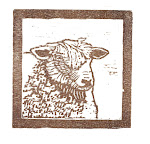I haven't been around these parts recently. Things have been happening, though, and at times it's been quite difficult to deal with those things. It's a salutary lesson to me that things ain't always plain sailing, and sometimes all you can do is to pick yourself up, dust yourself down, and carry on.
Here in the South-West of the UK, things haven't been so easy for those of us who have livestock - my vets say that there has been a huge wave of young animals going down with pneumonia due to the wet, humid weather, and we have been no exception. Ruby, the bottle fed lamb, got it first, and fortunately a single antibiotic and anti-inflammatory injection sorted her out. Her brother Yan Lamb, the largest and most magnificent of the triplets, got it next, but after several emergency vet call-outs (never within office hours, how did he do that??) we were no further on. He definitely had had pneumonia, but the usual treatments weren't bringing him back to full health. The 4th vet to see him (who happens to be a homeopathic vet) diagnosed an intestinal blockage, and recommended that, if we wanted to give Yan Lamb a chance to survive, we should send him to the Bristol Vet School straight away, the following morning, where they have large animal surgical facilities. This we did. Poor Yan was really unwell by the morning, obviously in more pain, and I was reluctant to put him through a journey to a strange place, but he had Ruby with him for company, and the lovely vet at Bristol felt it was worth a try. Sadly, though, it wasn't to be - Yan Lamb turned out to have an intussuception, which is where the large intestine telescopes in on itself and necrotises, and he had to be put to sleep. This meant that poor Ruby had a night at Bristol on her own (they shut at 5pm, and I couldn't get back there to pick her up before they closed) which she didn't actually mind too much because she was outrageously spoiled throughout by the staff there. Even the children from the on-site creche came down to see her the next morning. She was pleased to be home, though, and apart from shouting her head off at various points through the journey, is none the worse.
I am proud of the fact that we didn't hesitate when it came to making a decision for Yan Lamb. Gut blockages in sheep can be, apparently, quite curable, depending on where they are. If the rumen is blocked, the prognosis is very good, and without actually examining Yan Lamb fully, nobody could tell whether he had a blocked rumen or not; so I don't doubt that we did the right thing. Even the journey in the trailer can sometimes dislodge a physical blockage, so the vet at Bristol told me (she said that she has often seen severe colic cases in horses where the animal has walked off the lorry perfectly all right). Yan Lamb was very friendly and loved people, so I don't really think that the whole experience would have been as stressful for him as for a more nervous creature. But it was all very horrible, and to have lost him anyway was such a sadness.
But there we go - sometimes you just have to pick yourself up and plod on, and that's what we have been doing. Poor Foz was away for work the whole time Yan was at Bristol, and this was a huge worry for him. He is now away in Chicago (how terrible, huh?) but is anxiously keeping in touch. I think it's probably worse if you are miles away and can't do anything, rather than being there on the spot and able to take action.
But the rest of the flock are fine, and I have to keep hanging on to that fact. The bit of me which is coldly pragmatic says that Yan Lamb was probably the most expendable one of the group, and that if we had to lose a lamb, it was better that the ram lamb should go rather than the ewe lambs, all of whom are definite breeding stock for the future. But even that bit of me acknowledges that it was a very sad thing to have lost an animal at all.
 (Bit blurry, and this is actually a later version than the original, but it does show the segments quite well.)
(Bit blurry, and this is actually a later version than the original, but it does show the segments quite well.) Well, it turned out exactly the size I had wanted it to, but what I hadn't factored in is that hats fit best on a person's head if they are about an inch smaller than the actual circumference measurement of the wearer's bonce... I seem to have knitted something that looks more like a lampshade.
Well, it turned out exactly the size I had wanted it to, but what I hadn't factored in is that hats fit best on a person's head if they are about an inch smaller than the actual circumference measurement of the wearer's bonce... I seem to have knitted something that looks more like a lampshade.
